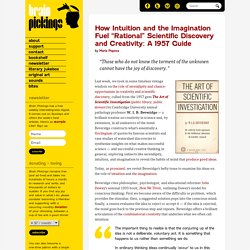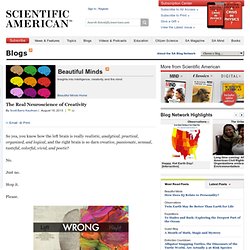

How Intuition and the Imagination Fuel “Rational” Scientific Discovery and Creativity: A 1957 Guide. By Maria Popova “Those who do not know the torment of the unknown cannot have the joy of discovery.”

Last week, we took in some timeless vintage wisdom on the role of serendipity and chance-opportunism in creativity and scientific discovery, culled from the 1957 gem The Art of Scientific Investigation (public library; public domain) by Cambridge University animal pathology professor W. I. The Real Neuroscience of Creativity. So yea, you know how the left brain is really realistic, analytical, practical, organized, and logical, and the right brain is so darn creative, passionate, sensual, tasteful, colorful, vivid, and poetic?

No. Just no. Stop it. Please. Thoughtful cognitive neuroscientists such as Anna Abraham, Mark Beeman, Adam Bristol, Kalina Christoff, Andreas Fink, Jeremy Gray, Adam Green, Rex Jung, John Kounios, Hikaru Takeuchi, Oshin Vartanian, Darya Zabelina and others are on the forefront of investigating what actually happens in the brain during the creative process. How and where imagination occurs in human brains. Philosophers and scientists have long puzzled over where human imagination comes from.

In other words, what makes humans able to create art, invent tools, think scientifically and perform other incredibly diverse behaviors? The answer, Dartmouth researchers conclude in a new study, lies in a widespread neural network -- the brain's "mental workspace" -- that consciously manipulates images, symbols, ideas and theories and gives humans the laser-like mental focus needed to solve complex problems and come up with new ideas. Their findings, titled "Network structure and dynamics of the mental workspace," appear the week of Sept. 16 in the Proceedings of the National Academy of Sciences. "Our findings move us closer to understanding how the organization of our brains sets us apart from other species and provides such a rich internal playground for us to think freely and creatively," says lead author Alex Schlegel , a graduate student in the Department of Psychological and Brain Sciences.